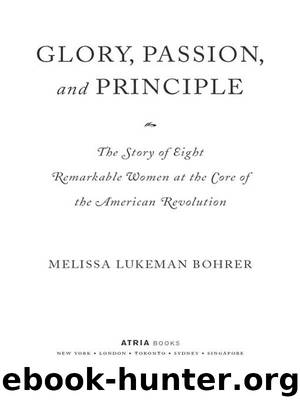Glory, Passion, and Principle by Melissa Lukeman Bohrer

Author:Melissa Lukeman Bohrer
Language: eng
Format: epub
Publisher: Simon & Schuster
Published: 2003-07-15T00:00:00+00:00
Lydia Darragh, the daughter of John Barrington, was born about 1728 and raised in Dublin, Ireland. Little is known of her childhood except that she was part of a large and loving family. After meeting and falling in love with her family tutor, William Darragh, the thirty-four-year-old son of a clergyman, she married on November 2, 1753, in the Friends Meeting House in Dublin, at twenty-five years of age. As a woman, she was described as “soft spoken and willowy, of fair complexion and delicate appearance. She had light hair, blue eyes and was extremely neat.” 6 Another friend described her as a “small, weakly woman.” 7
She and William came to America shortly after their wedding and, like many Quaker settlers before them, went to Pennsylvania, eventually settling in Philadelphia. They were well-known members of the Monthly Meeting of Friends in Philadelphia, the Quaker organization in the city, and regarded by their community as devout believers. The Quakers as a community held strong ties to the city of Philadelphia, as their founder William Penn had been given the land that would become Pennsylvania, and built and named the city around 1682: Philadelphia means “city of brotherly love,” the embodiment of Quaker ideology.
Though Quakers were Christians who believed in Jesus, they did not require their members to adhere to any one formula or belief, as faith to them was an inner experience of the love of God and love of man, practiced in the spirit of Christ. Since a Quaker’s connection with God was direct, there was no need for a bridge in the form of a minister or priest; thus they formed a society, rather than a church. Fervent believers in the freedom of speech, religion, and education, their creed was simplicity—in dress, lifestyle, and surroundings.
Lydia and William were both raised with this ideology and embodied it in how they chose to live. William worked as a tutor in America, continuing his practice of helping people, and Lydia would give birth to nine children, four dying in infancy prior to 1777. Those who survived were Charles, born in 1755; Ann, 1757; John, 1763;William, 1766; and Susannah, 1768. Even with her home filled with five babies, Lydia tried to help people outside. As early as 1766, an advertisement in the Pennsylvania Gazette appeared under her name, announcing, “The subscriber, living on Second Street, at the corner of Taylor’s Alley, opposite the Golden Fleece Tavern, takes this method of informing the Public that she intends to make Grave-Clothes and lay out the Dead, in the Neatest Manner, and as she is informed a person in this Business is much wanted in this City, she hopes, by her Care, to give satisfaction to those who will be pleased to favor her with their Orders.” 8
It is unknown whether she received work from this advertisement, but it seems she certainly tried. What is also unknown is at what point she and William departed from their Quaker creed regarding neutrality in war. By 1777, however, with the British occupation, their city would scarcely resemble that of ten years earlier.
Download
This site does not store any files on its server. We only index and link to content provided by other sites. Please contact the content providers to delete copyright contents if any and email us, we'll remove relevant links or contents immediately.
| American Revolution | Civil War |
| US Presidents |
Fanny Burney by Claire Harman(25784)
Empire of the Sikhs by Patwant Singh(22172)
Out of India by Michael Foss(16312)
Leonardo da Vinci by Walter Isaacson(11903)
Small Great Things by Jodi Picoult(6095)
The Six Wives Of Henry VIII (WOMEN IN HISTORY) by Fraser Antonia(4790)
The Wind in My Hair by Masih Alinejad(4424)
The Lonely City by Olivia Laing(4120)
The Crown by Robert Lacey(4105)
A Higher Loyalty: Truth, Lies, and Leadership by James Comey(4033)
The Iron Duke by The Iron Duke(3639)
Millionaire: The Philanderer, Gambler, and Duelist Who Invented Modern Finance by Janet Gleeson(3569)
Sticky Fingers by Joe Hagan(3454)
Alive: The Story of the Andes Survivors by Piers Paul Read(3310)
Papillon (English) by Henri Charrière(3269)
Joan of Arc by Mary Gordon(3258)
Stalin by Stephen Kotkin(3086)
Aleister Crowley: The Biography by Tobias Churton(3019)
Ants Among Elephants by Sujatha Gidla(2924)
